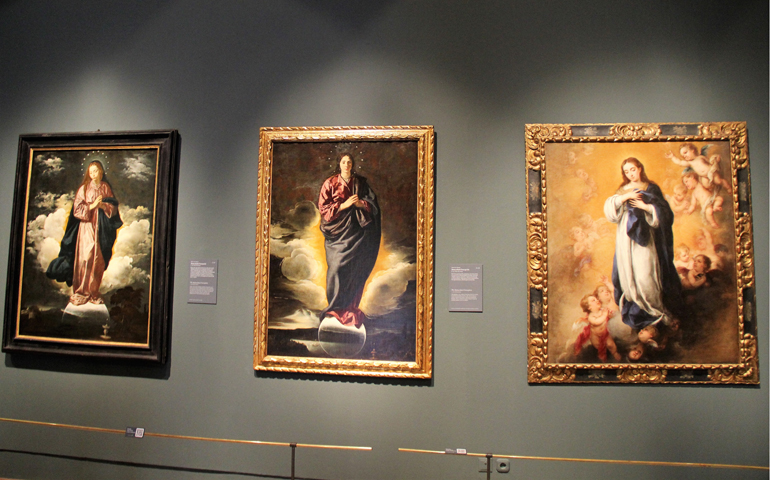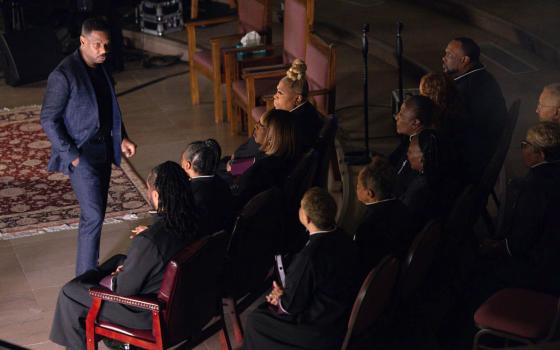
Three depictions of the Immaculate Conception, from left, two by Diego Velázquez and one by Bartolomé Esteban Murillo (Nachama Soloveichik)
Visitors to Santa María de la Sede, Seville's cathedral and the world's third largest church, need to peer over the baptismal font from behind a stanchion to glimpse Bartolomé Esteban Murillo's dimly lit "Vision of St. Anthony of Padua" (1656).
The painting still bears the scars of a late 1874 theft, in which thieves cut off the bottom right corner of the canvas -- where St. Anthony kneels -- and sold it. About a year later, an antique dealer in New York recognized the re-stretched canvas, purchased it and turned it over to the Spanish consulate. It returned to Seville after Prado Museum conservators restored it.
"That story needed to have this end, because San Antonio is the one who finds everything that we lose," said guide Elisa Simon, on a tour of the cathedral. "If you lose something, you don't have to search for it. You pray to San Antonio, and it comes back."
Standing before the painting, Simon calls attention to the obvious elements: the saint's attributes (a lily vase, open Bible and the Christ Child), as well as the flying putti circumscribed by clouds. But she also notes a less apparent element: the interior design.
"This is the typical floor that we have in Seville," Simon said. "It is a convention."
That Seville was important to Murillo (1617-82) -- "the most popular Baroque religious painter of 17th-century Spain," according to Britannica -- is undeniable. He was baptized in the city where he was born about 400 years ago and where he spent virtually his entire life, save a handful of years in Madrid. He painted for Seville's monasteries and cathedral, as well as private commissions. He often depicted lower-class subjects, such as genre scenes of poor children eating fruit.
Somewhat less certain was the role Seville played in the life and work of Diego Velázquez (1599-1660), renowned for his court paintings, most notably the 1656 masterpiece "Las Meninas." Although Velázquez was born in Seville, he barely looked back after being called to Philip IV's court in Madrid, where he spent nearly the last two-thirds of his life.
Ten Murillo paintings and nine by Velázquez comprise the exhibition "Velázquez. Murillo. Sevilla" (on view through Feb. 28), produced at Seville's stunning Baroque building Hospital de los Venerables by Focus Foundation -- an arm of Spanish engineering and solar energy firm Abengoa. The juxtapositions compare and contrast the ways both artists approached certain subject matter, and curator Gabriele Finaldi, director of London's National Gallery, makes the case that the city of Seville played a supporting role in the process.
"It seems clear after seeing the exhibition that Murillo had to know Velázquez's work, although, of course, he developed his own distinctive style," Mark Roglán told NCR. Roglán is director of Southern Methodist University's Meadows Museum in Dallas, which lent Murillo's "Saint Justa" (circa 1665) and "Saint Rufina" (circa 1665), depicting Seville's patron saints, to the exhibit.
Both painters shared a stylistic "inclination to naturalism" and display "superb technical skills" in their mastery of light and color. But Velázquez's approach was more sophisticated and modern than Murillo's, in part because he had the unique chance in the king's court to expose himself to so many of the European masters, according to Roglán.
In the 17th century, Seville was one of the world's largest cities. Being born in such a cosmopolitan, vibrant hub afforded both painters many opportunities. "Art from all corners of the world was traded there; there was wealth to make important commissions and sustain artists; and the city enjoyed a rich cultural heritage from Roman times to their century," Roglán said.
Murillo became more identified with the city, as he remained in Seville, while Velázquez worked primarily in Madrid and few of his paintings remain in his home city. But it made its mark on him as well. "The mostly sunny Seville has a very special light, an element that is essential to the work of both artists," Roglán said.
Religious subject matter also divided the artists. Murillo painted many more devotional subjects than Velázquez, but the latter painted many crucifixions and other religious scenes. "Velázquez painted princes and gods, while Murillo concentrated more on the theme of virgins and saints among others," as an exhibit announcement puts it.
Roglán agrees. He sees Murillo's works as very approachable and accessible, while Velázquez's are more cerebral.
"The viewer can see all the tenderness of a young girl that holds in her hand the palm of martyrdom, or be moved by Murillo's beautiful 'Immaculate Conceptions' ascending to heaven," Roglán said. "In Velázquez's case, perhaps we find a more intellectual approach, whether it his group compositions done in a very classical way or distilling the essence of Christ's passion, as his crucifixion at the Prado Museum uniquely exemplifies."
At first blush, the three depictions of the Immaculate Conception hanging side-by-side in the exhibit are quite similar. All three Virgin Marys stand on half-moons suspended in cloud-filled heavens, and each drapes a blue shawl over a white or lavender robe. But the joy of seeing the three together lies in the notable differences.
Two of the works were created by a teenaged Velázquez, while Murillo painted the third when he was in his 50s. It's possible not only to read influence in one direction, but also to see more of a broader ecosystem of influence.
In the two by Velázquez -- one (1618-19) from the National Gallery of London and the other (circa 1618) from the Focus Foundation in Seville -- the Virgin is crowned by a halo of stars. In both, she stands on a full orb, although only the top part of the moon touching her feet is illuminated. And in both, Velázquez set the heavenly scene in context, with portions of landscapes just peeking out from above the bottom of the frame. In the Seville painting, viewers can make out a ship on a wide river, trees, rolling hills and a fountain; the London work adds architectural elements to the trees and fountain.
To Velázquez, the Immaculate Conception was doubtlessly a heavenly occurrence, but it had its grounding firmly in this world. Murillo, by contrast, surrounded his Virgin Mary with putti, or childlike, near-naked angels in his work (circa 1670), from the collection of the Nelson-Atkins Museum of Art in Kansas City, Mo. No earthly landscape invades the heavens in this painting, and Murillo depicted the Virgin with a halo of light.
"This 'Inmaculada' is not grounded in any landscape, nor is it defined by a realist strata between Earth and heaven; here we are transported in a vaporous golden cloud where the Inmaculada is surrounded by angels," Julián Zugazagoitia, director of the Nelson-Atkins, said in an interview with NCR. "They are arranged all around her, but the more vividly present putti are arranged in an ascending diagonal that serves as her grounding axis."
Also in the exhibit is an early painting of Velázquez's from the Prado Museum collection that is certainly grounded in Seville. In "The Adoration of the Magi" (1619), the newly-married painter cast his father-in-law and teacher Francisco Pacheco, who lived in Seville, as the kneeling, white-bearded king on the left of the work. As a Prado description explains it, Pacheco had a close relationship with the Jesuits, and the work, the artist's largest and most ambitious at the time, was likely painted for a Jesuit church. (No doubt depicting one's father-in-law as a biblical figure could score necessary points for a newlywed.)
Other figures in the work also suggest a family portrait. The younger, kneeling king in the foreground, dressed in orange and holding a chalice, appears to be a self-portrait of Velázquez, and the depiction of the baby Jesus might be based on the artist's only daughter, born the year the painting was made in Seville. He would go to Madrid a few years later.
"While it may seem surprising, the inclusion of portraits in an Adoration of the Magi is compatible with the traditions of that iconography. There are numerous examples in Western art," the Prado description notes. "This practice can be related to the nature of this biblical episode, which affirms the universal character of the good news."
Zugazagoitia doesn't think that Murillo's connection to Seville played a role in his museum's early acquisition of the work, but he notes the neighborhood around the Nelson-Atkins, built in the early 1930s, was inspired by Seville. Kansas City urban planner and developer J.C. Nichols created the first open-air shopping mall with the "flair of a European environment," and replicated the Giralda, the bell tower of Seville's cathedral (which was originally a minaret of a mosque), as well as much of the architectural detailing, according to Zugazagoitia.
"Our two cities have their stories intertwined. As Seville and Kansas City remain sister cities today, we feel very much compelled to participate in the [fourth] centennial celebrations of Murillo," he said. "I know that our painting felt very much at home when driven on Kansas City Avenue [in Seville] from the airport into the Hospital de los Venerables."
[Menachem Wecker is co-author of the book Consider No Evil: Two Faith Traditions and the Problem of Academic Freedom in Religious Higher Education.]



